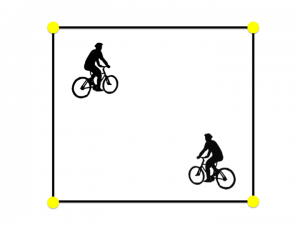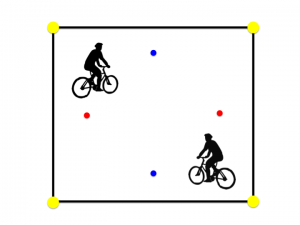We want to avoid contact with other road users on public roads. For this, we use two cognitive skills: motor preparation and selective attention. These skills are very similar: motor preparation relates to future movements (here, changing direction) and selective attention relates to the observation of future objects. In practice, motor preparation and selective attention are difficult to separate from each other, and that is because observation and movement are so strongly intertwined: the observation of an object almost always results in a movement. The exercises on this page therefore also relate to both aspects, motor preparation and selective attention.
1. Bicycle cage matches

The exercises for seeing danger are in fact matches between teams of two or more cyclists, and they are jointly referred to by the name that we will also use for the space in which they take place: the bicycle cage. We describe these bicycle cage matches for teams of two cyclists, but the expansion to more cyclists is straightforward. “Bicycle cage” refers to a space where only the two cyclists reside, and who can not leave them either. In practice, this space is indicated by a chalk line figure (square, rectangle, circle, …) on the asphalt of a large parking space, possibly combined with pylons at the corners of the figure. The cyclists in the bicycle cage must maintain a certain minimum distance with respect to each other, which we refer to as the “safety zone”. Whether two cyclists ride within each other’s safety zone is detected with feelers. In the ideal scenario, these feelers are electric, and a light comes on when the feelers of two bicycles come into contact with each other.


Within the chalk lines figure gates have been placed through which the cyclists must ride in a certain direction. The prescribed direction is indicated by the color of the pylons: the blue pylon must be passed on the right and the red pylon on the left. There are two types of gates: single-pylons and double-pylons. The single-pylon gates are located at the edge of the bicycle cage, and the double-pyon gates are located in the inner part.
The goal of a bicycle cage is to ride, as a team, through as many gates as possible (obtaining the highest possible gate score) and getting as few penalty points as possible. The penalty points are deducted from the gate score and the team with the highest result (gate score minus penalty points) wins the match. The number of gates and the penalty points are counted by judges standing on the edge of the bicycle cage. (Judges are other cyclists who also participate in the bicycle cage competition.)
These are the rules of the competition:
- One must stay inside the bicycle cage. If one comes outside the chalk lines, one gets penalty points.
- The gates may only be taken in the prescribed direction. If one takes a gate in the wrong direction, one gets penalty points.
- One may not enter the safety zone of another cyclist. Violation of this rule is detected with feelers and converted into penalty points.
The difficulty of a bicycle cage match can be varied by varying the size, shape and design of the bicycle cage:
- The size of the bicycle cage. The smaller the cage, the more difficult.
- The shape of the bicycle cage. A round bicycle cage (e.g., a circle) is more difficult than a bicycle cage with straight walls.
- The number and placement of the gates. The more gates and the closer they are on each other, the more difficult.
- The width of the gates. The narrower the harder.
The difficulty of a bicycle cage match can also be varied by means of instructions. For example, one can give the instruction that it is not allowed to brake. Following this instruction requires that cyclists predict the movements of their team member more in advance and also their own movements. Brake use can be detected by a brake light.
2. Cycling on the public road
The bicycle cage matches approach cycling on the public road: the cyclist has a goal (riding through as many gates as possible) that he wants to achieve in an environment in which the other road users form a potential danger (being tapped). With a little imagination we can also see cycling on the public road as a bicycle cage match. In this way we move the cycling skills exercise from a parking space to the public road.